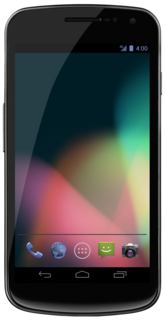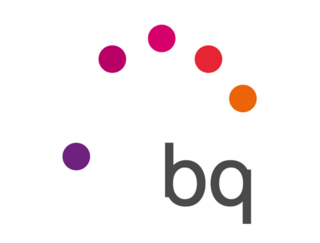Related Research Articles

A smartphone is a mobile device that combines cellular and mobile computing functions into one unit. They are distinguished from feature phones by their stronger hardware capabilities and extensive mobile operating systems, which facilitate wider software, internet, and multimedia functionality, alongside core phone functions such as voice calls and text messaging. Smartphones typically contain a number of metal–oxide–semiconductor (MOS) integrated circuit (IC) chips, include various sensors that can be leveraged by their software, and support wireless communications protocols.
Android is a mobile operating system based on a modified version of the Linux kernel and other open source software, designed primarily for touchscreen mobile devices such as smartphones and tablets. Android is developed by a consortium of developers known as the Open Handset Alliance and commercially sponsored by Google. It was unveiled in November 2007, with the first commercial Android device launched in September 2008.

Xperia is the brand name of smartphones and tablets from Sony. The name Xperia is derived from the word "experience", and was first used in the Xperia X1 tagline, "I Xperia the best".

The Galaxy Nexus (GT-I9250) is a touchscreen Android smartphone co-developed by Google and Samsung Electronics. It is the third smartphone in the Google Nexus series, a family of Android consumer devices built by an original equipment manufacturer partner. The phone is the successor to Google's previous flagship phones, the Nexus One and Nexus S.

Xiaomi Corporation is a Chinese multinational electronics company founded in April 2010 and headquartered in Beijing. Xiaomi makes and invests in smartphones, mobile apps, laptops, home appliances, bags, shoes, consumer electronics, and many other products. Xiaomi is also the fourth company globally after Apple, Samsung and Huawei to have self-developed mobile system-on-chip (SoC) capabilities.

The Motorola Photon Q 4G LTE (XT897) is a smartphone manufactured by Motorola which runs on Sprint's 4G LTE network. The "Photon Q" has a 4.3-inch touchscreen and a 1.5 GHz dual-core processor. It runs the Android operating system and includes a built-in, sliding keyboard similar to the one on the Motorola Droid 4.

The Sony Xperia ZR is a touchscreen-enabled, HD Android flagship smartphone designed, developed, and marketed by Sony Mobile.

The Sony Xperia Z2 is an Android-based smartphone unveiled, manufactured, and marketed by Sony and was released in April 2014. Under the codename "Sirius", Xperia Z2 serves as the successor to the Sony Xperia Z1. Like its predecessor, the Xperia Z2 is water and dust proof with an IP rating of IP55 and IP58. The phone features an IPS LED display, a Snapdragon 801 processor and the ability to record 4K videos. The Xperia Z2 also allows removable microSD storage up to 128 GB.
Android One is a family of third-party Android smartphones promoted by Google. In comparison to many third-party Android devices, which ship with a manufacturer's customized user interface and bundled apps, these devices run near-stock versions of Android with limited modifications, and a focus on Google services. Android One devices receive OS updates for at least two years after their release, and security patches for at least three years.

The Nokia X2 is an entry-level smartphone which was announced and released by Microsoft Mobile on 24 June 2014. It is the successor of the Nokia X, being the first smartphone running version 2.0 of the Android-based Nokia X platform operating system. The Nokia X family of Android phones was discontinued on July 17, 2014.

The Sony Xperia Z3 is an Android smartphone produced by Sony. Part of the Sony Xperia Z series, the Xperia Z3, at that point known by the project code name "Leo", was unveiled during a press conference at IFA 2014 on September 4, 2014. It was first released in Taiwan on September 19, 2014.

The second generation Moto X, marketed as moto X and referred to in the media as Moto X (2014), is an Android smartphone developed by Motorola Mobility. Released on September 5, 2014, it is the successor to the original Moto X released in 2013. It was succeeded by the third generation Moto X Style and Play family, announced on July 29, 2015.
A projector phone is a mobile phone that contains a built-in pico projector.

The Sony Xperia Z3+ is an Android smartphone produced by Sony. Unveiled on April 20, 2015, it is an upgraded version of 2014's Xperia Z3 with improved specifications, a thinner body and Android 5.0 "Lollipop". The phone was awarded for the best European Multimedia Smartphone for the year 2015-2016 by European Imaging and Sound Association.

The Samsung Galaxy A9 (2018) is a midrange Android smartphone produced by Samsung Electronics as part of the Samsung Galaxy A series. It was announced on 11 October 2018 at the A Galaxy event in Kuala Lumpur, Malaysia, as the successor to the Samsung Galaxy A9 (2016). Galaxy A9 (2018) is the world's first smartphone that features 4 different cameras on the rear. It features a 6.3 inch Super AMOLED Infinity Display with curved edges similar to the Samsung Galaxy A8 (2018) and supports Dolby Atmos immersive sound technology It is the brand ambassador for Ayushmann Khurrana. It is the predecessor of Samsung Galaxy A70.

Moto G7 is a series of Android smartphones developed by Motorola Mobility, a subsidiary of Lenovo. It is the seventh generation of the Moto G family and was first released on 7 February 2019. As with the last generations which introduced the Plus and Play variants, this series has introduced the Power variant as well. There are 4 variants in the seventh series.

BQ was a Spanish company brand of user electronics devices, such as smartphones, tablets, e-readers and 3D printers among other products.
